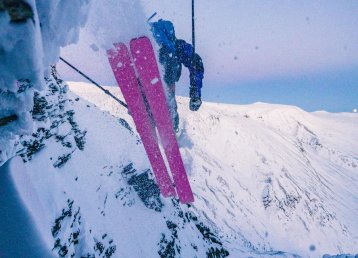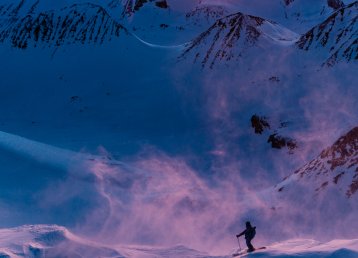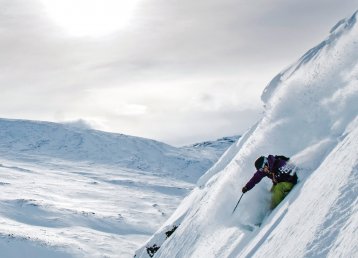Abisko, May 15, 2020. Nothing is as it should this winter, except mountain guide Stefan Palm’s raccoon look. Despite the fact that it has snowed five metres, or more, in the Riksgränsen mountains, and even though everyone I meet manages to throw out a comment about spring being delayed and that no one can remember a winter with worse weather, Stefan Palm is sporting classic tan lines from sunglasses. This is what he has always looked like, or at least how I have always seen him up here for more than 30 years. Stefan is one of Sweden’s most famous mountain guides; his workplace is wherever there are mountains and snow, all around the world. Every year, from the end of March to the end of May, Abisko Mountain Lodge is Stefan’s basecamp.
— But I have to add that Stefan got those tan lines during the last couple of days. He didn’t look quite like himself before that, says Kristoffer Borg, who works at Brasserie Fjällköket.
— On the other hand, nothing is as it should this winter.
Stefan smiles. His weather-beaten tan is a result of spending a couple of hundred days a year on skis. He has been doing this since he was old enough to decide for himself what he wanted to do.
Born to ski
Stefan is in Abisko with his family: wife Pia and son Max. His daughter Robina has just gone to Amsterdam, where she studies communication. If you were to define skiers, the Palm family could very well be that definition. Max Palm won – as the youngest winner of that competition ever – the Nordic Freestyle Championships in the winter of 2019. That same year he won the Freeride Junior Tour, which he repeated the following year. Max Palm has overtaken most normal and not-so-normal skiers since he was 12 years old. Max is up here because he had hoped to defend his title in the Scandinavian Big Mountain Championships, but unfortunately, the event was cancelled. His mother, Pia, has actually won the SBMC three times. What goes through her mind when she watches her son ski?
— Well, to be honest, it’s scary during competitions. But otherwise, if we ski together or when I watch him go, I’m very calm.
— Max has amazing control. I’ve seen him, you know, ‘get charged’ basically all the time since he started skiing, so I know that he knows what he’s doing when it comes to skiing.
That Pia would ski was more or less written in her DNA. Her family consisted of and still consists of skiers. Her parents loved the mountains and skiing; her cousins were skiers too. When the family went on holiday, they packed the children into the car and went to the mountains. Pia became a ski instructor. She ended up in Riksgränsen after the kind of experiences we normally abbreviate as curiosity. She went there and instantly fell in love with the place as well as a blond guy working at ‘Sporten’, which is what the ski school in Riksgränsen was called at the time. During her time in Riksgränsen, Pia won SBMC three times and ended up on the Swedish Interski team representing Sweden’s ski schools worldwide. She climbed the mountain Muztagh Ata, 7,546 metres high, and for a long time, she held the ‘height record’ among Swedish females. Naturally, Pia walked up Muztagh Ata to ski down. She walked in ski boots that were five sizes too big, so her feet would not get frostbitten.
"A cycle of winter, snow and travelling around the world"
Skiing was not as obvious for Stefan, growing up not far from the golf courses in Skanör-Falsterbo in the southernmost part of Sweden. But somehow, his mother had decided Stefan would do something with that adventurous spirit of his, and she sent him up to Kiruna to study mountain sports. (To be on the safe side, ensuring the boy would be accepted, she had filled out the application as well as forged his signature.) This is how he, raised near Sweden’s southernmost tip, came to be defined by Sweden’s Arctic destination.
Skiing also gave Stefan and Pia the direction they wanted in life. When summer came to Riksgränsen at the beginning of June, they took a flight to New Zealand. They worked there during the southern hemisphere winter. When spring claimed that part of the world, they flew back north, to the Alps, before returning to Riksgränsen sometime in March. A cycle of winter, snow and travelling around the world. These days their home base is Chamonix in France, where Max goes to school and develops his skiing talent, and it is actually not that far from Robina’s school in the Netherlands. But since Stefan still lives his life as a guide at the world’s best ski resorts and heli-ski lodges, home base is something we can take with a pinch of salt. Wherever he lays his sunglasses, that’s his home. Today he guides in Iceland, Japan, Russia, Norway, Chile – where he is called Sabueso Sueco, ‘the Swedish scent hound’ by Chilean mountain guides who marvel at the Swede’s ability to sniff out the best skiing – and here, of course, from his northern base at Abisko Mountain Lodge.
Fourteen years in a row
Abisko Mountain Lodge began as an idea: Dick Johansson had become a mountain guide as one of the first Swedish graduates, with Stefan and three other friends. Mina Johansson-Dahl felt she was done with her hotel job. These days their lodge is one of the best watering holes in Abisko, thanks to exceptional service, good food and a long northern-lights season. The skiing season runs from March to June, and skiers from all over the world come here to enjoy the powder. But it is also the place to go to wash down slow-cooked elk fillet with an excellent Pinot Noir from Burgundy.
There is a group sat at the table next to me, and they tell me they have been coming here for fourteen years in a row and that they are actually also celebrating “the best day of skiing they have ever had”. I join their toast and congratulate them. Not bad at all. Fourteen years in a row. I take another bite of elk, then a sip of wine. There is something special about having the best skiing day of your life and then enjoying a good meal, fourteen years after you started.
Riksgränsen Banked Slalom
It’s all about carving. No jumps, no flips, no rails. Just the beautiful art of turning on a snowboard. But apart from that, a decade of carving, Riksgränsen Banked Slalom is just a great happening in the very north of Swedish Lapland.
Responsibilities and footprints
In many ways, Pia and Stefan introduced heli-skiing to this part of the world. In the 1990s, they returned to Riksgränsen after one of their journeys and suggested it ought to be offered at the hotel here, too. You can have many opinions about heli-skiing and travellers who arrive from all corners of the globe by plane. Talking to them about it, both Stefan and Pia say that they understand the problem and contemplate it, but because their guests know that some of the best heli-skiing in the world is actually found right here, the equation for the company is simple.
"More and more young people want to do ski touring"
Dick Johansson also says:
— We talk about this all the time. Our responsibility and our footprint. But now it seems not many new skiers come in wanting to heli-ski. On the contrary, more and more young people want to do ski touring.
— Some want a combination, of course: perhaps be flown into an area and then do ski touring. But in general, there’s no influx of new clients who only want to get flown up the mountainsides.
— We’re aware of our impact, and we try to do other things in a sensible manner. But of course, if we wouldn’t be able to do it, we wouldn’t be able to run this facility. It’s always tricky, no matter what you do, he concludes and smiles a sad smile. They love the mountains.
The love for skiing
Max Palm puts down his maths book. Like we mentioned, he is one of the best young free-riders in the world right now. He was hoping to defend his victory from last year in Scandinavian Big Mountain Championship, but instead, he does home studies and hopes to get a few turns on the Riksgränsen mountain. Max Palm loves skiing.
— Last year, Stefan tells us, we had the worst pre-season ever in Chamonix and the Alps. There was hardly anything you could ski on, apart from a button lift higher up the valley with icy, artificial snow. Max was grinding it out there, day in and day out, all by himself. Not even friends his age had the patience.
— But Max didn’t give up, says Stefan, and you can catch a hint of pride when he speaks of his son’s determination.
I ask Max himself what he likes the most: the challenges involved in riding a steep, exposed and almost life-threatening line – as they do in freeride competitions – or just cruising powder for several kilometres.
— No, I suppose I’m not a big fan of powder skiing. I probably have more of a skate-view on skiing. I like using the terrain, jump rocks, turn on wind drifts and manoeuvre through steep, exposed parts.
— It doesn’t have to be steep and dangerous at all, but the lines should be beautiful, offering variety and an opportunity to be creative.
— But what do you think is the best bit about being up here? You have come here for quite a few spring-winters now.
— It’s the light, he says in a flash. That you can ski all the time, it’s what I like: skiing.
The Avalanche technician
Jenny Råghall is stationed in the Swedish mountains around Kebnekaise and her job is to compile Avalanche forecasts for the area. This is a day at her office.
The light
It is, of course, the light that made Max’s parents – Stefan and Pia – fall in love with this place once upon a time. The midnight light. Not for the raccoon tan’s sake, but for the sake of skiing. I have no idea how many times I have heard them talk about the feeling of skiing in almost pink-tinted powder when the sun approaches the horizon in the middle of the night, and the mountains are only theirs.
— Two things stand out when it comes to skiing here, and of course, it’s about the fact that you can ski on cold snow, real powder, far, far into May, Stefan says.
— But above all, it’s the sun. Having the midnight light and the midnight sun. So even if a day starts with clouds and bad weather, which in this case usually means good weather because it provides more snow, there is always a chance you can head out for a run a bit later in the day.
— What you don’t have time for during the day, you might have time for at night. Because not only do we have long runs, we also have long days, Pia adds.
— It just can’t get much better than that, says Stefan and lets Max go first down
the valley. Max aims for a small rise about halfway down the ride. Stefan and Pia look at each other. They know soon, their son will take off. They know he likes it. He does it with such control.
A backcountry skier’s dream of a design hotel
Niehku Mountain Villa is a stunning design hotel and a hideaway in Riksgränsen, Swedish Lapland. In an Arctic environment, this design hotel and mountain vista stand out as a pilgrimage for travelers searching for heli-skiing, good food, hikes, and a great time. The northern Sámi word for dream is Niehku – and right here, it is a dream come true.

































